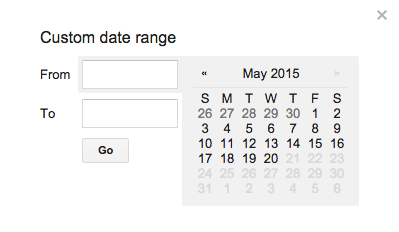From Dick Eastman’s Online Genealogy Newsletter May 20, 2015. Used by permission.
There’s a lot more you can do with Google than just searching the entire Internet. For instance, you can search for web pages added to Google’s indexes within a range of dates. The most common use for this is to look for pages added within the past 30 days or perhaps within the past week.
For instance, I have an elusive “brickwall ancestor” that I have been trying to identify for years: Washington Harvey Eastman. Unfortunately, his three names are not unusual although the combination of those three names is a bit unique. If I simply enter his name into a Google search, I receive many “hits,” including a few from newsletter articles I have written.
Since I have already searched for him before, I have already seen all the “hits” that have been available for some time. There’s no need to go back and wade through all those same hits time after time. I only want to see the NEW web pages that mention his name. Luckily, Google supplies the tools to do this. In fact, there are two different methods that are closely related.
Method #1: Search from the main Google search page
Go to http://google.com and enter the words or phrase that you wish to search for. For instance, I might search for:
“Washington Harvey Eastman”
The quotes indicate that I want to search for those exact words in that exact order. It will ignore “Washington Eastman” as well as “Washington H. Eastman” and other variations of his name.
When the results appear, look slightly above the results and click on “Search Tools.”
Next, look just above the first “hit” and notice the words “Any time.” This is a pulldown menu. Click on “Any time” to view a range of options: past hour, past 24 hours, past week, past month, and past year. Clicking on any of those choices will display only web pages added to or updated by Google within the time frame specified.

In my case, I typically search for my elusive ancestor on the first day of each month by entering his name and then specifying “past month” in the pulldown menu.
NOTE #1: When searching by date, Google displays “hits” that contain all three words, Washington Harvey Eastman, but not necessarily in that order. However, any new pages added in the past month with all three words in that exact order normally appear at the top of the list. New pages that contain some or all of the words in a different order are typically displayed further down the list.
NOTE #2: Google displays the web pages added to Google’s Indexes within the specified dates, not the date in which the web page was published on the World Wide Web. However, in most cases Google indexes the page on or very shortly after the date it was published.
If the selections of past hour, past 24 hours, past week, past month or past year do not meet your needs, you can always use the “Custom Date Range.” For instance, if you last searched Google for an elusive ancestor four months ago, you can create a custom date search of all web pages containing his or her name that have been added in the past four months. Once again, go to http://google.com and enter the words or phrase that you wish to search for. When the results appear, look just above the first “hit” and notice the words “Any time.” Click on that pulldown menu and you will see the options listed earlier as well as one more: Custom Range.

Selecting the Custom Range option opens a mini calendar where you can specify the exact start and ending dates for the search. Then click on GO to continue the search, using the newly-specified dates.
Method #2: Use Google’s Advanced Search Page
Another method of searching by a date range is to use Google’s Advanced Search Page; this page allows all sorts of advanced search options.
Google used to display a link to the Advanced Search page on the main page at www.Google.com but apparently removed the link some time ago. However, the page is still available. To find it, go to Google.com and search for it, of course! Go to Google.com and enter:
Google Advanced Search
Click on the first “hit” for that search. Another, shorter method, if you can remember it, is to simply type in the direct URL: http://www.google.com/advanced_search.

The Advanced Search page has many options, including “Last Update.” Click on that to specify past hour, past 24 hours, past week, past month and past year. The results will be the same as those found by using Method #1 described earlier. However, you will notice that the Advanced Search page does not have a selection for Custom Range. If you need to specify a Custom Range, you will need to use Method #1 described earlier.
Using the above Advanced Search option will result in Google displaying only “hits” that match the parameters you specify.
While Method #2 may take a few more keystrokes than Method #1, it can yield more targeted results when used with other Advanced Search features. Watch for my descriptions of how to improve your genealogy research with many of these features in a future article.
